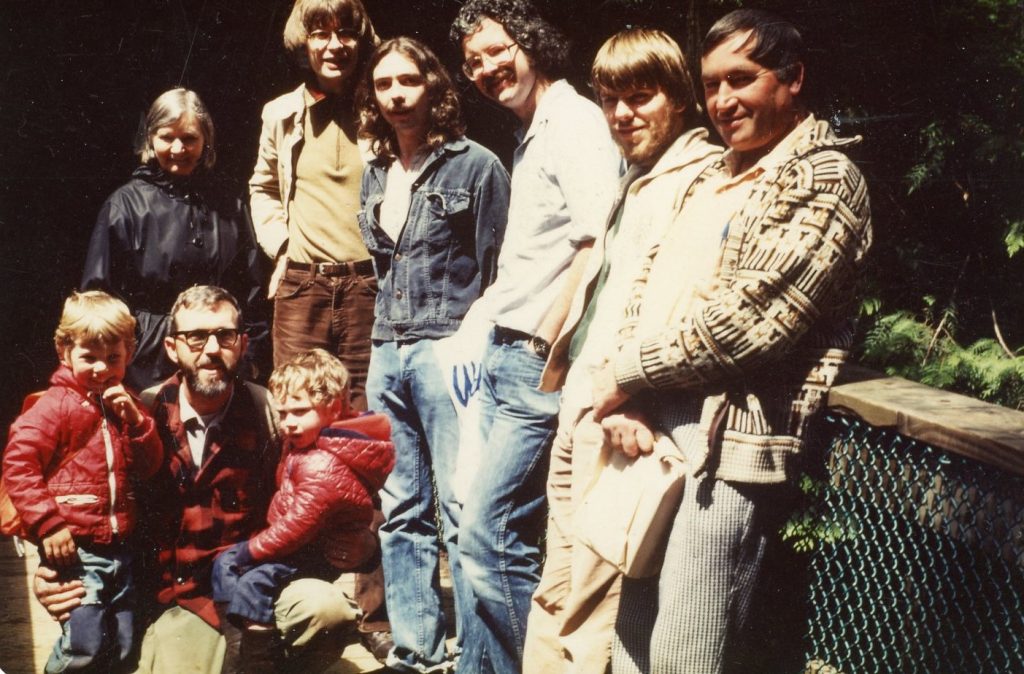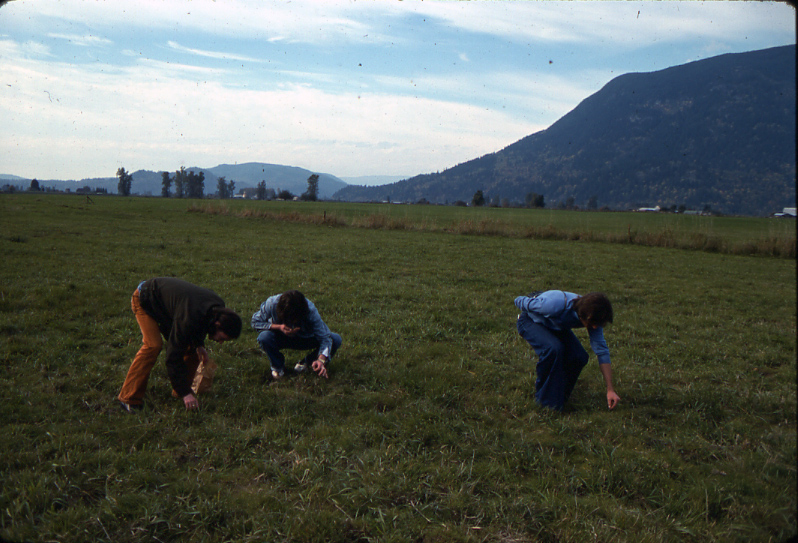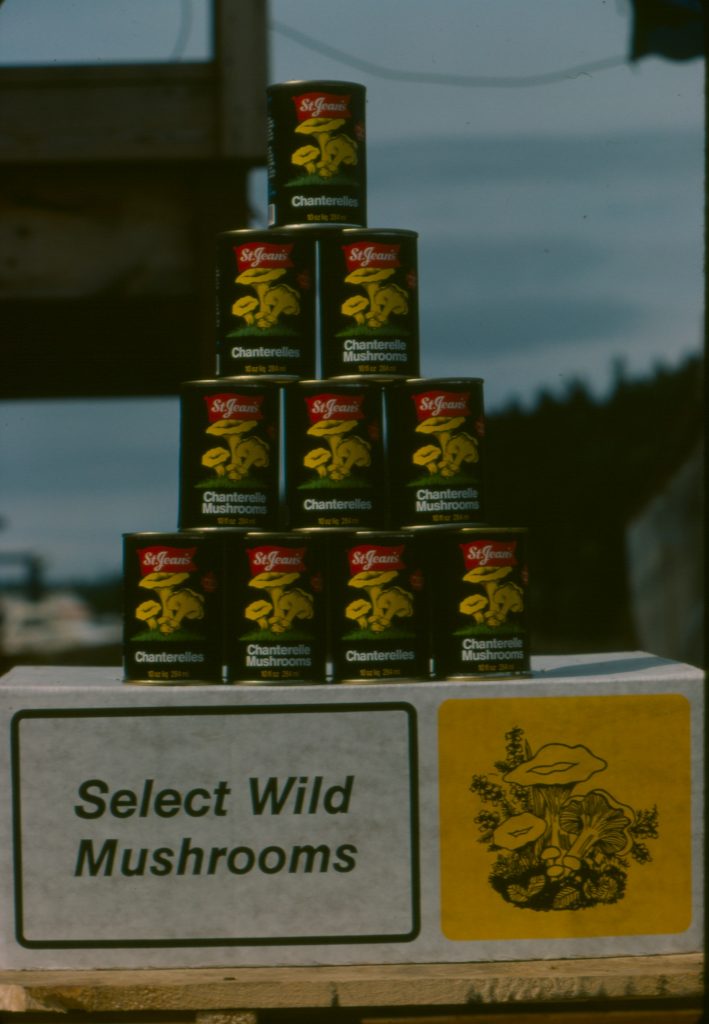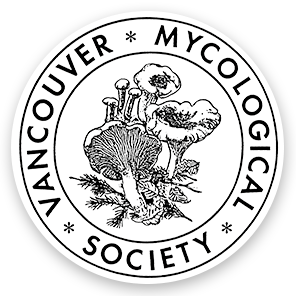by Paul Kroeger
Vancouver’s mushroom club has always been considered a very special and unique group of enthusiasts, with a distinct blend of interests and skills.Comparison to other regional mushroom clubs and natural history groups has led many to comment that VMS is one of the more interesting and fun bunch of people they’ve ever encountered. Forty years ago some very different interests converged to create an amateur society for the study and appreciation of fungi.This is why Vancouver’s mycological society has its own distinct mushroom culture, so to speak.
Here we’ll look at some interests that brought mycological society people together, and some things that have changed over four decades of VMS.
Science
Science had recently established the Fungi as being a vast group of diverse organisms constituting their own Kingdom, or major limb in the tree of life (Whittaker, R. H. 1969. New concepts of kingdoms of organisms. Science. 163 (3863): 150–60). The fungi had just begun to get the attention they richly deserved, and a keen group of avid naturalists from the Vancouver Natural History Society formed the nucleus around which a mushroom club developed or grew at the end of the 70s, in 1978-1979.
During the 1970s the burgeoning study of ecology had just begun to reveal many vital roles of fungi in forest ecosystems. British Columbia’s universities, government agencies and corporations supported research in mycology because of the importance of fungi to British Columbia’s valuable forest industry.
UBC’s Botany Department mycologist Dr. Robert Bandoni ran the mycology lab that spawned our club’s dedication to what is now called “citizen science”. Some early Bandoni-Lab students who helped develop the VMS included Andy MacKinnon, Keith Siefert, Richard Summerbell, Gavin Kernaghan, Sharmin Gamiet and Eduardo Jovel. Professor Bandoni especially appreciated the establishment of our club as a welcome relief from the distractions of seasonal flurries of public enquiries about mushrooms; he could now refer all those curious people to us.
We’ve documented the macrofungi of Manning Park for over 30 years, and the mushroom populations of many other areas in BC were first described from VMS field trips. Amateur mycologists have discovered many new mushroom species here and elsewhere.
Dr. Mary Berbee, the current UBC Mycology professor, continues to support amateur contributions to mycology research in BC, and students from UBC are still actively involved with and contribute much to the VMS’s endeavours.

Circa 1980. Left to right: Dick Fraser & sons. Helene & Ole Juul, Paul Kroeger, UBC students Andy MacKinnon and Keith Siefert, Les Wigglesworth. (Photo: A. McKinnon) (photo: Kitsy Fraser)
Counter-Culture
In the 1970s hallucinogenic “Magic Mushrooms” were very popular and high profile, often appearing in the news, and several kinds of wild magic Psilocybe mushrooms were abundant in coastal British Columbia communities. Counter-culture interests in magic mushrooms added many colourful characters to the membership of our early mushroom club.For more on BC magic mushroom history see our webpage essay: https://www.vanmyco.org/about-mushrooms/psychedelic/brief-history-magic-mushrooms-bc/.
It’s interesting to note that wild magic mushrooms were very common in the 1970s and 1980sand several species grew abundantly as weeds in urban landscaping. Psilocybe stuntzii sometimes formed fairy-rings and arcs or vast swathes in recently installed lawns of newly developed areas and the extensive use of bark mulches in institutional landscaping produced great crops of Psilocybe baeocystis, Psilocybe cyanescens and Psilocybe stuntzii around hospitals, courthouses, police stations and schools. At our annual VMS Mushroom Shows at VanDusen Gardens, throughout the 1980s, we always displayed Psilocybe baeocystis gathered from the grounds by the gardeners.
During the 1990s many alternative uses for wood waste products were developed, and landscaping materials and practices changed. The building booms of the 1960s and 1970s had slowed down, the nature of development changed, and with a lack of new habitats and introduction of watering limitations most of the once abundant weedy urban magic mushrooms disappeared.
The original magic mushroom in Canada, the Liberty Cap or Psilocybe semilanceata, grows in wet pastures. Agricultural fields in the Fraser Valley and in the Fraser delta around Richmond produced abundant crops during the late 1960s into the 1980s, the most productive fields being pasture lands seasonally grazed by cattle or horses. This is no more. Marginal farmland, which was often leased out for grazing because it wasn’t suitable for more intensive agriculture, has been built upon while remaining productive agriculture lands are used differently. Cattle are not often grazed outdoors and both dairy and meat cattle are now mostly raised indoors while fields are used for intensive hay or feed-maize cropping or other types of farming. A little mushroom that was once plentiful, and that changed the cultural landscape of Vancouver and BC, is now scarce.

Picking Liberty Caps in Fraser Valley 1977 (photo: Stan Czolowski)
Cuisine
Cuisine was also changing rapidly when the club was formed with natural fresh, organic and wild foods gaining popularity. Post-war baby-boomers were more affluent and better travelled than previous generations and had developed tastes for cuisine from diverse cultures; many novel and exotic dishes and ingredients were introduced including mushrooms. Until then an abundance of choice edible wild mushrooms had grown in our forests largely unnoticed except by some immigrants from mushroom-loving countries who could enjoy their beloved foods in peace, privately and with little competition.
Then in 1978 a Japanese market for Canadian pine mushrooms (Tricholoma magnivelare or murrillianum) was developed and a gold rush style stampede into the woods began. At the time, Japanese domestic Matsutake (Tricholoma matsutake) had severely declined and even the somewhat less desirable large white North American pine mushroom, known then as Armillaria ponderosa, became a valued and expensive substitute.
It’s said that Canadian pine mushrooms were first discovered by Japanese-Canadian citizens interned during World War II growing near internment camps in Greenwood and Kaslo in the Kootenays, New Denver in Slocan Valley, and near Lillooet and Bridge River. Until the commercial harvest began, multi-generational Japanese Canadian families had continued to revisit their patches every mushroom season. Then suddenly the “White Gold rush” stampede deprived them of a much enjoyed traditional family activity that was one of the few silver linings to brighten the cloud of their dark WWII experience.
Other wild mushrooms were soon being commercially harvested for export to European countries, especially chanterelles and morels. Chanterelles were canned for export to Germany at St. Jean’s Cannery in Nanaimo, and for a time, fresh chanterelles were packed into brine in barrels for export to European canneries. The shipping of brined fresh mushrooms for later canning was stopped after some chanterelles spoiled in transit, causing illness from heat-stable Staphylococcus bacterial entero-toxins in canned products.
Various dried BC mushrooms also became available in our markets and were exported abroad. Boletes and morels are especially suited to being sold dried, but other local mushrooms such as chanterelles and lobster mushrooms have also become widely available in dried form. Processing of wild mushrooms to produce high quality dried products is described in this video from Royal Roads University: https://www.youtube.com/watch?v=x1V0jMV-J7Y.

BC canned chanterelles for export to Germany. St. Jean’s cannery, Nanaimo 1985 (photo P. Kroeger)
As foreign markets for BC wild mushrooms opened, local interest and demand also increased and wild harvested mushrooms started to appear in many local produce stores and farmers’ markets.
Canadian restaurants also began to incorporate more wild mushrooms into their menus. Unfortunately not all chefs were familiar with safe preparation of mushrooms and this resulted in a couple of in famous mass poisonings in Vancouver restaurants. In one case in 1987 improperly bottled chanterelles caused severe botulism poisoning in 11 people; in another incident in1991 fresh morels served raw at a banquet made 77 people sick.
Landscapes Change
Landscapes have changed in south western British Columbia over forty years of VMS activities; mushrooming was different at the beginning. Large scale industrial clear-cut logging of the 1960s through the 1980s had resulted in extensive logging road systems throughout forested landscapes giving access to many productive forestremnants not yet logged but doomed soon to be. Within a couple hours drive of Vancouver were many forests abounding in interesting and edible mushrooms, though one might have to face thundering great loaded logging trucks barrelling toward you to get there. In the 1980s public sentiment began to change and protests against industrial destruction of old-growth forests began.
Field trips for the VMS were much more frequent in early years because there were many more places a fairly large group of us could go for a casual mushroom walk. Many parks, trails and areas of accessible forest land were a short driving time from the city, and even on weekends were not filled with other people. Fewer people were interested in mushrooms at first, so impressive fruiting of fungi could be seen in abundance. But as interest in mushrooms grew over the years, many areas near the city were regularly picked over for edibles, and the other fungi and their habitats (and mycologists) were increasingly disturbed.
The population of Greater or Metro Vancouver has more than doubled over the past 40 years (from 1,169,831 in 1981 to 2,463,431 in 2016) and human pressure on natural areas near the city is tremendous. Many parks, trails and recreation areas are packed with visitors every weekend and large numbers of users along with inadequate care, maintenance and repairs has deteriorated access trails making them unsafe, and degraded or damaged the natural environment people come to enjoy. People seem to “love it to death”.
VMS used to have many day trips to areas in the upper Fraser Valley and places around Hope but now it takes twice as long to get half as far. Heading east on the highway past the Port Mann bridge would take you through miles and miles of agricultural land because much of the Fraser Valley was composed of distinct small towns and cities surrounded by farms and undeveloped land. Now urban development has filled much of the valley, suburbs have grown like giant slime-moulds absorbing rural lands as their streaming plasmodial paved road systems carry more propagules to colonize yet more land. Getting out of the city now almost means travelling beyond Hope.
Mushrooms change
Some once-common popular edible mushrooms have become scarce near Vancouver but others have appeared as new and then spread within the growing city. In 1983 mini-parks were created in many parts of the city and the horticultural Rhododendron “Anna Rose Whitney” was planted out, soon to produce from their root-balls enormous crops of mushrooms identified as Stropharia riparia (a native species) at the time. This mushroom was evidently introduced from abroad and found its way into the horticultural trade to hitchhike with transported nursery stock. It’s now called Leratiomyces percevalii, a less attractive name than that of the delightfully rhyming native’s Stropharia riparia. Whatever its name might be, this introduced species is now a widespread common weed mushroom in gardens here and around the world.
In 1984 a new species of mushroom was found growing abundantly in the UBC Botanical Gardens, a peculiar little Hypholoma that arises from buried sclerotia or tubers. We named it Hypholoma tuberosum Redhead & Kroeger and soon after publication it was reported from the USA, Japan, France, Germany, Belgium and Australia. The species was found to grow wild in a bog in New South Wales Australia where sedge peat was mined for use in the nursery industry, and appears to have found its way around the world from there hitchhiking on the commercial plant trade.
Another import probably also from Australia is Stropharia aurantiaca, now called Leratiomyces ceres, which first showed up in Vancouver in 1974 in landscaping of the newly built Arbutus Village development. This beautiful and distinctive little orange- capped mushroom has over the past decade become a common weed mushroom in wood chip mulches here, much as it now grows elsewhere around the world.
Of course, the alien imported mushroom of greatest importance and concern right now is the Death Cap, or deadly Amanita phalloides. The VMS has been central to the discovery and documentation of this dangerous mushroom in Canada. After it was found growing in Seattle Washington we put out warnings and asked VMS members to look out for it and to spread the word it might be here. In 1997 it was indeed found in BC, under sweet chestnut trees at Lake Errock near Mission. We’ve been able to document its spreading occurrence and distribution, and have helped warn the public of this new threat to public health. For more on BC death caps see our webpage: https://www.vanmyco.org/about-mushrooms/poisonous/amanita-phalloides/.
New types of mushroom poisoning have also been recognized over the past forty years. In 1992, Amanita smithiana was first shown to be poisonous, causing kidney failure when eaten mistaken for pine mushrooms. https://www.vanmyco.org/about-mushrooms/poisonous/amanita-smithiana/. Several species once considered safe edible have been implicated in causing sickness in recent years. See https://www.vanmyco.org/about-mushrooms/poisonous/ Anomalous Edible Mushroom Poisonings & Symptoms table.
Names Change
I’ve discussed several changes in the world of mushrooms over the last 40 years, but perhaps the most challenging change for enthusiasts is in what we name our mushrooms. When VMS started pine mushrooms were Armillaria ponderosa, honey mushrooms were Armillariella rather than Armillaria, hedgehogs were Dentinum repandum instead of Hydnum and hawks wings were Hydnum not Sarcodon. As DNA technology is applied to look at different fungi, more and more species native to North America are being recognized as distinct from Old World species whose names we’ve been using. New understanding of evolutionary relationships among fungi is also changing the genus names into which species are placed and new genera are being proposed, so the mushroom names change yet again!
And So Do Books
In earlier years North American mycologists relied heavily on European literature to find names for our New World mushrooms. Many amateur mycologists used mushroom books from Europe, often translated into English, which were commonly illustrated with beautiful reproductions of watercolour paintings. A very popular and useful early book was Collins Guide to Mushrooms and Toadstools by Lange and Hora, a 1963 English translation of the Danish 1961 Svampeflora with beautiful little colour paintings of an interesting variety of fungi.
There were a mere handful of North American mushroom guide books available at first, and most had just black and white photographs. Standard home-grown North American mushroom books you might find on a shelf of early members of VMS include: The Savory Wild Mushroom 1962 (1971) by McKenny and Stuntz of Seattle; Edible and Poisonous Mushrooms of Canada 1962 by Groves and published by Agriculture Canada; Mushrooms of North America 1972 by Orson Miller, an early all-colour book; The Mushroom Hunter’s Field Guide 1958(1963) by Alexander Smith or its colour 1980 version; and the colour illustrated A Field Guide to Western Mushrooms 1975 also by Alexander Smith.
Certain new books came out around the time of VMS’s beginnings that covered many more species than any previous field guides. Mushrooms Demystified by David Arora first came out in 1979 and soon was the go-to guide for devoted mushroomers. The Audubon Society Field Guide to North American Mushrooms 1981 by Gary Lincoff was very popular for those who like to use comparison with photos to identify fungi.
For more serious identifiers there were How to Know the Gilled Mushrooms 1979 and How to Know the Non-gilled Mushrooms 1981, both by Smith, Smith and Weber in The Pictured Keys Nature Series of Wm. C. Brown Publishers. For the extremely serious identifier there was also Keys to Agarics and Boleti (Polyporales, Boletales, Agaricales, Russulales) 1983 by Moser with 400 pages of keys, printed in tiny font, to thousands of mushroom species.
As interest in mushrooms has grown over the past decades, so has the number and variety of mushroom books. Many regional field guides have come out recently, and books about various other aspects such as mushroom cultivation or uses of fungi especially as food or medicine, or monographs dealing with just particular groups of mushrooms are now numerous. The revolution in computer technologies has also given us many novel internet resources, so looking up any unfamiliar mushroom name now takes only a few moments spent at a keyboard or gadget.
The VMS was formed just when fungi were exploding into public consciousness. Our club has thrived in an environment where mushrooms and other fungi are conspicuous, varied and around to be found for much of the year. Using fungi for food or medicine, might be the first reason most people join a mushroom club but the general of fungi soon hooks them.
Studying the vast and fascinating, but previously oft overlooked realm of fungi has been a frontier of exploration, innovation and discovery. There are “so many mushrooms but such little time”. For four decades the Vancouver Mycological Society has been along for a great exciting ride, and it’s been fun.
